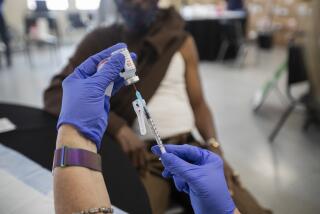L.A. Cancer Study Reveals Ethnic Variations in Rates
- Share via
The first comprehensive study of cancer in Los Angeles County has identified striking differences in the incidence and death rates of certain cancers among the county’s diverse racial and ethnic groups.
The report, said to be the first of its kind in the country, is intended to lay the groundwork for education and screening programs that experts believe could help cut the cancer death rate in the county by as much as 50% over the next decade.
For example, the new data shows that the lung cancer rate among Latinos is relatively low. But tobacco use appears to be rising among Latino teen-agers. If anti-smoking programs could be targeted to that group, the researchers believe that a new epidemic of lung cancer might be averted.
“Life style profoundly influences the occurrence of various forms of cancer,” said Dr. Lester Breslow, a UCLA professor and co-author of the report released Tuesday. “ . . . Los Angeles could become a model for the nation by significantly reducing the number of people dying from cancer by the year 2000.”
Among the findings of the UCLA-USC study:
--Overall cancer rates are about 25% lower among Latinos than other whites in the county. But the overall cancer rate among black men is significantly higher than both, largely because of high rates of lung and prostate cancer.
--Rates of cervical cancer are 50% higher among black women than whites, and more than twice as high among Latino women as among other whites. Those discrepancies are believed to reflect in part differences in access to screening through Pap smears.
--The breast cancer rate among white women--106 cases per 100,000 women--is significantly higher than among black and Latino women, 79 and 62 per 100,000, respectively. One reason for that may be the fact that white women tend to postpone childbearing.
According to the researchers, white women give birth to their first child five years later than black women on average. Although it is not entirely clear why that increases their risk of breast cancer, researchers say certain hormones are suspected to play a role.
--The rate among white women in the county is also higher than the national average of 92 per 100,000. On the whole, however, ethnic and racial cancer rates in the county generally follow national trends.
“Cancer is both a social and a biological phenomenon,” Breslow said at a press conference Tuesday. “We think of it as a biological phenomenon, but it emerges largely as a result of the way people live.”
For that reason, the study’s authors hope their findings will enable universities, hospitals and public and private agencies to design and win funding for the kinds of prevention programs they say could halve the number of cancer deaths, projected to reach 14,200 in the county in the year 2000.
Such efforts should include programs to stop tobacco smoking, currently blamed for nearly 30% of all cancer deaths, the researchers said. They might also encourage dietary changes, such as restricting fats, suspected by some to contribute to breast and prostate cancers.
The researchers also called for increased access to low-cost screening in cases where screening has been proven effective in preventing cancer deaths. Those include breast cancer screening by mammography and cervical cancer screening by Pap smear.
35% Get Mammograms
Only 35% of the women in Los Angeles County for whom breast cancer screening is considered advisable have ever received a mammogram, according to Helen G. Brown of UCLA’s Jonsson Comprehensive Cancer Center, one of the report’s authors.
She and others pointed to the significance of economics in controlling cancer.
For example, Brown said the average cost of a mammogram is $100 to $150 in Los Angeles County. Unless public and private programs make available lower-cost mammography, less affluent women remain unable to take advantage of a proven preventive tool, she said.
Similarly, the cervical cancer screening has been reduced in recent years by cuts in public funding for family planning services, Brown said. Breslow noted that many private insurance programs do not cover the costs of Pap smears.
“We read a lot about the lack of money for emergency services,” said Breslow, a former director of the California Department of Health Services. “ . . . But even more threatened by the curtailment of health funding are preventive services for cancer.”
Public Support Needed
Asked to estimate what the programs proposed in the report would cost, Breslow said they would require “very sizeable public support.” Brown said up to 70,000 lower-income women would benefit by an annual, low-cost Pap smear, costing $7 to $10--just one small component of the total cost.
“I just think we’re fighting a losing battle until the economics of the problem are addressed,” said Dr. Richard Steckel, director of UCLA’s Jonsson center. Steckel said the report simply illustrates a broader national problem.
The study, based largely on statistics collected by the Los Angeles Cancer Surveillance program at USC, brings together for the first time extensive data for a metropolitan area on cancer incidence and mortality broken down by race, gender and geography.
Asked to explain the lower overall cancer rate among Latinos, the researchers traced it largely to their traditionally lower rate of smoking. However, Dr. Ronald K. Ross of USC said tobacco use among Latino adolescents appears to have risen to the rate of other whites.
The high cancer rates among black men may be traced in part to tobacco use, which is higher among blacks than whites, the researchers said. They said there is some evidence that hormone levels and diet may contribute to the high prostate cancer rate among black men.
The authors of the report include Breslow, Brown and Nikki Herman-Shipley of the Jonsson center at UCLA, and Ross of the Norris Comprehensive Cancer Center at USC.
CANCER RATES BY RACE AND ETHNIC GROUP
A comprehensive study of cancer in Los Angeles shows that rates do differ by race and ethnicity. Black men overall have the highest cancer rate; breast cancer is twice as high in white women as Latinas.
The report was prepared by researchers at the Jonsson Comprehensive Cancer Center at UCLA and the Kenneth Norris Jr. Comprehensive Cancer Center at USC. It is based on a compilation and analysis of data gathered by the Los Angeles Cancer Surveillance Program at USC, the Los Angeles County Department of Health Services, the National Cancer Institute, the California State Vital Statistics program and U.S. Census data.
MEN (rates per 100,000)
Non-Latino Site Whites Latinos Blacks All Sites 424.7 324.6 458.8 Lung 81.9 48.9 106.5 Colon 42.5 27.2 42.1 Prostate 76.6 68.6 112.5 Lymphomas 17.6 11.8 10.6
WOMEN (rates per 100,000)
Non-Latino Site Whites Latinos Blacks All Sites 350.7 259.7 284.8 Lung 38.5 18.7 32.0 Breast 105.7 62.2 79.0 Colon 30.2 20.1 33.5 Cervix 8.1 20.8 13.6 Uterus 27.4 17.0 12.3
More to Read
Sign up for Essential California
The most important California stories and recommendations in your inbox every morning.
You may occasionally receive promotional content from the Los Angeles Times.









